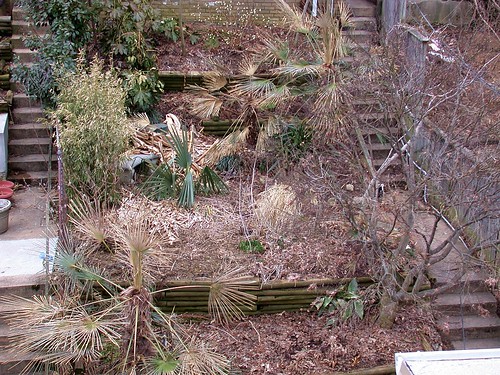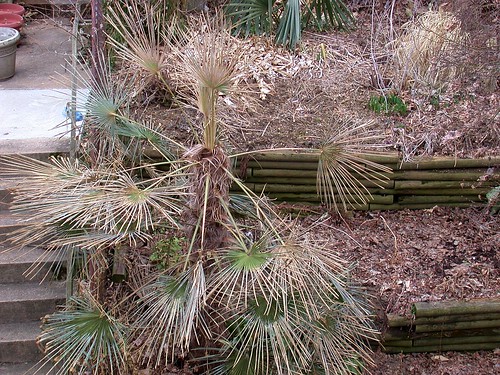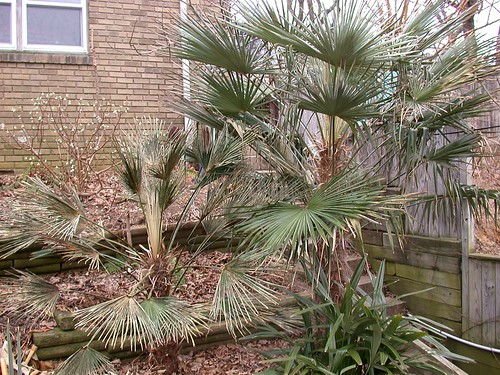
Garden, mid-March after our coldest winter in 20 years
Is my palm dead? Lots of people are going to be asking that question over the next few weeks because frankly, the palms look dead. The short answer: maybe, maybe not. Hardy palm legend (and mystery author) Tamar Myers supposedly once said, "don't declare a palm dead until spring, and don't declare one alive until summer."
As many of us in zone 7 discovered this winter, temperatures in the low single digits will cause severe damage to unprotected windmill palms (Trachycarpus fortunei). This was our coldest winter in 20 years and lows in the Washington, DC area bottomed out in January somewhere between 6 degrees and slightly below zero. Interestingly, my own low of 5 degrees in early January only caused significant damage to my "waggie", Trachycarpus wagnerianus. Two other windmill palms, T. fortunei "Nainital" and T. fortunei "Bulgarian", curled their leaflets and looked unhappy, but a week later showed virtually no damage whereas T. wagnerianus looked freeze-dried. Far more damaging were the several cold waves that followed, although subsequent lows were in the 9-12 degree range, showing that frequency and duration of cold is at least as important as the absolute low. As of mid-March, all of my palms are looking pretty rough.

Trachycarpus fortunei "Bulgarian", mid-March
So are my palms dead? Maybe, but maybe not; all I can really do now is cross my fingers and wait. Windmill palms are famous for recovering from massive damage, including "spear pull" and near-total defoliation. There's a very good chance that many of our area's dead-looking palms will put out new growth, but be patient: they may not show any signs of life until June or even July. It's not unusual for the tightly folded emerging leaf ("spear") to pull out after a cold winter, with the palm otherwise showing little damage and recovering quickly. The meristem (growing point) is buried deep inside the palm, with the young leaves developing from it surrounded by the bases of the older leaves. For every emerging spear there are several more in reserve that aren't yet visible. After a winter like this one, most if not all of these developing leaves are damaged or destroyed, leaving the palm to start from scratch. In severe cases the youngest leaves, as well as the spear, will pull right out. But as long as that meristem is still alive, it will recover and (eventually) push out some new leaves. Some growers advise hydrogen peroxide or fungicides in the hole to help prevent rot, but I've never tried this and my palms have (nearly) always recovered from spear pull.

Trachycarpus wagnerianus (left), T. fortunei "Nainital" (right), early February
I'll admit, I don't have high hopes for my waggie. The damage was so severe, and happened so early in the winter, and was followed by cold that damaged even the tougher palms, that I think this might well be the end of my decade-plus experiment with this species. But my "Nainital" and "Bulgarian" still have some green in their leaves, giving me some hope that they aren't goners. All I can do now is take my own advice and wait.
Assuming any palms survive, the tricky part is going to be next winter. Many of these palms are going to be severely weakened and the second winter may well be the death blow for them, even if it's not nearly as cold as the last winter. This happened with two of my waggies several years ago, when they recovered from near-total defoliation but suffered damage again the following winter, even though it wasn't nearly as cold. I'm not sure what to recommend, except to give the plants good care during the coming growing season, and possibly even protecting them next winter to increase their chances of pulling through it.

My T. fortunei looks unphased by the winter, but we did not get as cold as you did, and of course Sabal minor is fine. Around here, particularly near the oceanfront, it will be interesting to see if all of the S. palmetto plantings make it. Over the past decade more and more of them have been planted and I didn't see any that were protected ahead of the winter. There are several plantings of Butia capitata near my house in such glamorous locations by a car wash and laundromat, which have been there for years. I will be watching those this spring as well.
ReplyDeleteMine look like yours... no spear pull that I can find...Sabals and Needles out front look fine, it's the big Daddy Tracy in back tat has me worried. I'll be patient, however not sure other store owners will They will want instant pretty for tourist season... That's why this winter likely put us back so far here at the beech..
DeleteThanks, it has been a very long time since I've been in Virginia Beach--I don't remember seeing any palms but at the time they were completely off my radar. It might be interesting to go back sometime. I was at the Norfolk Botanic Garden a few years ago and was really impressed by their plantings--I definitely hope to get back there someday.
ReplyDeleteI'm in zone 6 just north of Cincinnati Ohio. I planted 2 trachys last summer that I bought while visiting my brother in Georgia. One was about 4 1/2 foot, the other about 2 foot with a decent trunk forming. Both heavily protected this winter. The bigger one is putting out lots of new growth but the little one is slow growing and has the slightest tint if yellow. I'm hoping it's from the tons of rain and not root rot. Time will tell.......
ReplyDeleteGood luck with your palms, hope they do well this year. I'm getting a bit nervous about my own...
DeleteAny spear pull on yours?
DeleteThis comment has been removed by the author.
ReplyDeleteMy windmills are now sprouting "flowers"! . . . Or whatever that yellow, broccoli-looking growth is. That's a good sign, right?
ReplyDeleteWhat you're seeing is the inflorescence, basically a cluster of flowers--the individual flowers themselves are tiny and produced by the thousands. My "Bulgarian" is almost completely fried but also putting out a single inflorescence (it produced several last year, the first time it bloomed). Definitely a sign that the palm is still alive, but I have to wonder whether it should be removed so as not to weaken the palm further.
DeleteIt looks badly damaged, but I hope your palms aren’t dead. Needless to say, they make stunning adornments in a garden, and it would be a waste to lose them. You’re right that the very least we could do is prepare our plants for the winter, or you could just opt for growing plants that are more resilient to harsh weathers.
ReplyDeleteMitchell Knapp @ Scenic Landscaping
Thanks Mitchell, still no sign of life on 2 of my windmill palms, but the third ("Bulgarian") is pushing out some new leaves. Since it was so badly damaged (and slow to recover) I may protect it this winter--even a mild winter could kill a palm that's already so weakened. But palms aside, most of the plants I'm growing are pretty reliable here, with the exception of my begonias--and with those I'm actively testing (and hopefully breeding) for hardiness.
DeleteI'm so sorry to hear that your palms didn't make it, they were very nice-looking. Unfortunately you may have cooked them to death; the trick in winter is not to keep them warm, but to keep them cold enough to stay dormant and not fry.
ReplyDeleteOther people have also emailed me and said this. My neighbor also had one that I planted on his property that was not heated and it also died. Could it be the ground that was frozen for two weeks is what killed them (the Feb polar vortex)? Would heating the ground with heating blanket have helped?
ReplyDeleteThanks for the reply and the condolences. Best, Peter
On the contrary, after reading your description I think you may have kept your palms too warm! The trick is not to keep them toasty warm in the winter but rather to keep them cold (and thus safely dormant) without letting it get below a certain temperature.
ReplyDelete